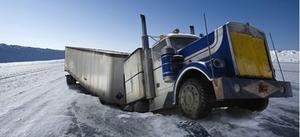InfrastructureGlobal warming: Arctic access by land will diminish, but improve by sea
Global warming over the next forty years will cut through Arctic transportation networks like a double-edged sword, limiting access in certain areas and vastly increasing it in others in absolute terms; winners are expected to be coastal communities, coastal resource-extraction operations, tourism, fishing, and shipping concerns; potential losers include inland mining and timber operations, inland oil and gas drilling, and smaller inland communities, often inhabited by indigenous peoples; Canada and Russia stand to lose the most winter-road potential as rising temperatures will prevent up to 400,000 square miles from hardening into potential roadways

This may become a more frequent occurence // Source: cosasexclusivas.com
Global warming over the next forty years will cut through Arctic transportation networks like a double-edged sword, limiting access in certain areas and vastly increasing it in others, a new UCLA study predicts.
“As sea ice continues to melt, accessibility by sea will increase, but the viability of an important network of roads that depend on freezing temperatures is threatened by a warming climate,” said Scott Stephenson, a UCLA graduate student in geography and the study’s lead author.
A university of California, Los Angeles release reports that winners are expected to be coastal communities, coastal resource-extraction operations, tourism, fishing, and shipping concerns, the researchers say. Potential losers include inland mining and timber operations, inland oil and gas drilling, and smaller inland communities, often inhabited by indigenous peoples. Even northern Canada’s famed Tibbitt–Contwoyto “diamond road,” said to be the world’s most lucrative ice road, is expected to suffer, according to the researchers.
The findings appear in the June issue of the scholarly journal Nature Climate Change.
“Popular perception holds that climate warming will mean an opening up of the Arctic, but our study shows that this is only partly so,” said co-author Laurence C. Smith, a UCLA professor of geography and author of The World in 2050: Four Forces Shaping Civilization’s Northern Future (Dutton Books, 2010). “Rising maritime access for ships will be severely countered by falling vehicular access on land.”
Along with veteran UCLA geographer John A. Agnew, Stephenson and Smith integrated existing accessibility models for the Arctic with the National Center for Atmospheric Research’s widely used climate models for the coming century.
The researchers averaged month-to-month accessibility rates for two time periods: 2010 to 2014 and 2045 to 2059. They then compared the two scenarios.
With an overall anticipated temperature increase of 3.6 to 6.2 degrees Fahrenheit by 2050 — and an even sharper increase of 7.2 to 10.8 degrees Fahrenheit in the winter — climate change is expected to have more dramatic effects in the Arctic than anywhere on Earth.
A major casualty will be temporary ice roads, according to the study. Constructed across frozen ground, lakes, rivers, and swampy areas using compacted snow and ice and applied sheets of ice, these roads currently provide access to vast swaths of inland terrain where the construction of all-weather roads is not economically viable.
As a result, all eight countries that border the Arctic — Canada, Finland, Greenland, Iceland, Norway, Russia, Sweden and the United States —